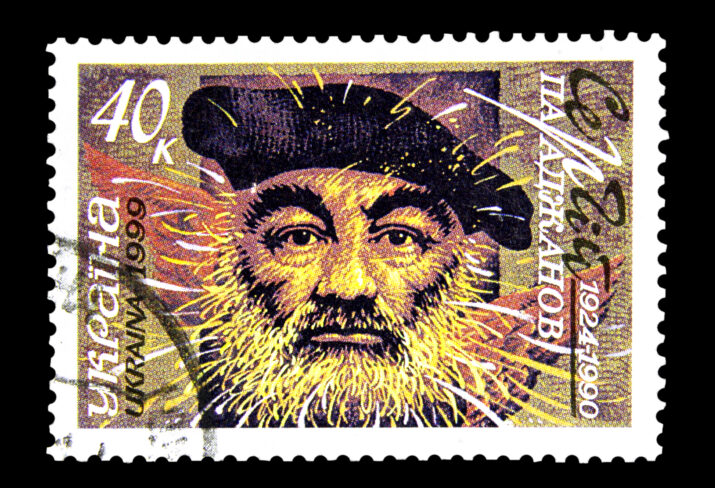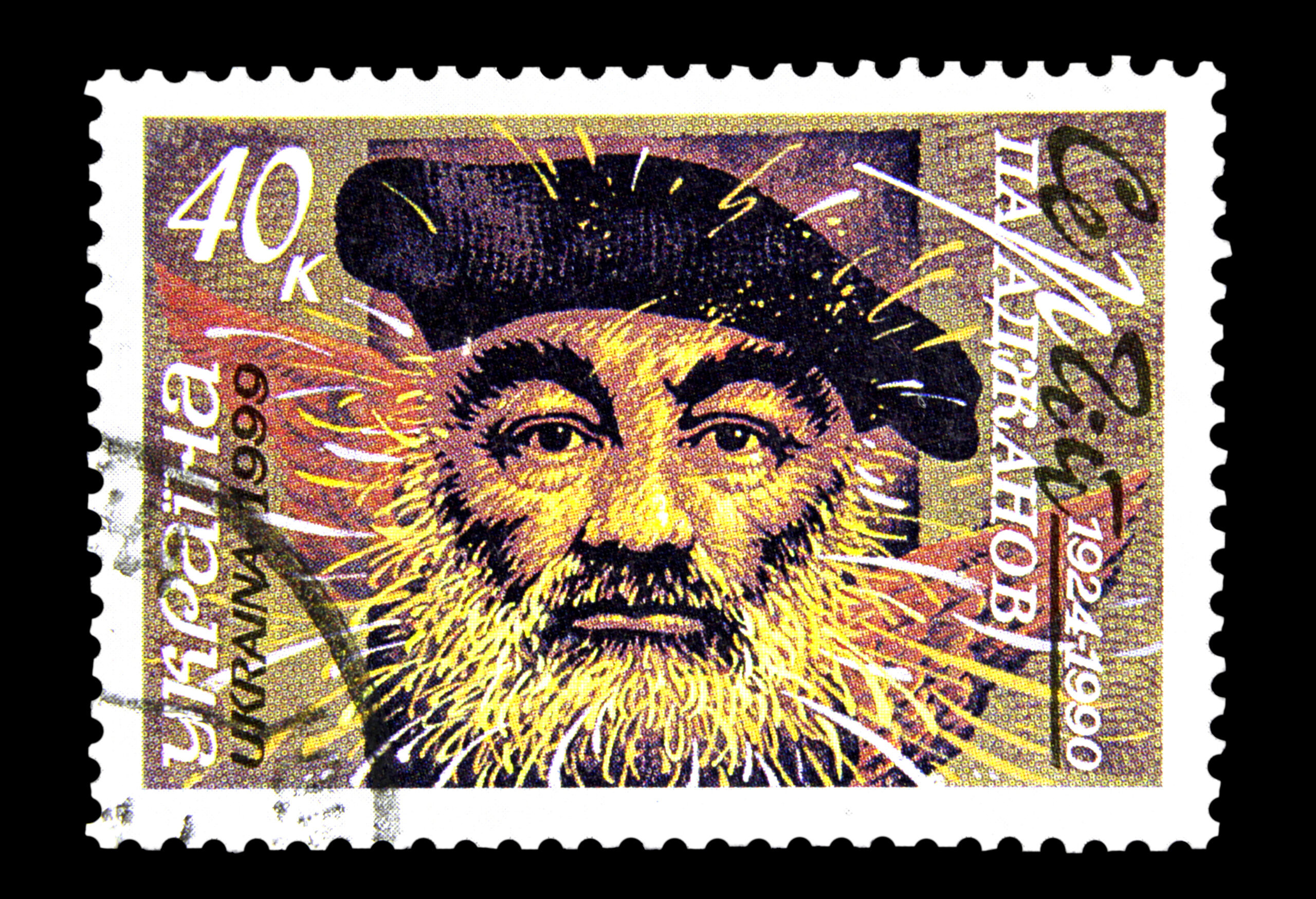

This is part of our special feature, Thinking Eurasia Now.
Eurasia is first and foremost a historical, cultural, and political construct (Kaiser 2004). So are its centers and margins. Using poetic cinema of the 1960s and 1970s in the Soviet Union and Ukraine and Sergei Paradzhanov’s films as examples, I demonstrate the possibility of alternative (cinematic) conceptualizations of Eurasia in the USSR. This is where reality and fiction merge and where spatial configurations reveal their arbitrariness and the opportunity for their own reconfiguration.
Poetic cinema
Poetic cinema originated in the avant-garde film aesthetics of the 1920s and 1930s, peaking in the 1960s and 1970s in the USSR. There is no uniform definition of poetic or lyrical film or cinema since poetic films transcend conventional genre norms by blurring their boundaries (Brunner 2022a). Nevertheless, films in this genre have common features. Poetic films constitute personal visions of the filmmakers in which the imaginative and the subjective as well as the world of things and the medial expression are more important than the dramaturgy of the plot (Ibid.). The categorization and definition of poetic films delimit avant-garde film art from cinema as a narrative medium that carries meaning or mediates actions (Orphal 2014). Filmmaker Maya Deren defines the poetic construct in film as “a ‘vertical’ investigation of a situation, in that it probes the ramifications of the moment, and is concerned with its qualities and its depth” (Sitney 2000, 178). Deren’s poetic “revelation of the moment” (Ibid., 185) brings the film’s plot to a (temporary) standstill. This moment leads to contemplating how the film—the narrative—was created.
Poetic cinema can fulfill a political mission of resistance when it breaks away from narrative structures. In particular, such a subversive function of the poetic could be produced in the Soviet context. The break from the conventional narrative can be understood and interpreted as a break from the norm at both the formal and the substantive level, as the two levels are usually related. Poetic films usually presuppose that the viewers have a challenging attitude, which is often associated with an attempt on the part of filmmakers to establish (poetic) film as a sophisticated art form and distinguish it from entertainment cinema (Orphal 2014). Because they are not mass produced, poetic films convey an aura of exclusivity that shakes ideological and political norms under certain circumstances. In the 1960s and 1970s in the Soviet Union, such exclusivity was remarkable both in terms of film aesthetics and film plots. From the perspective of film aesthetics, poetic cinema contrasted with the norms of socialist realism. In its plots, it encouraged alternative (cinematic) conceptions of geopolitical spaces and of Soviet Eurasia in particular.
Sergei Paradzhanov
The oeuvre of the Soviet film director Sergei Paradzhanov, one of the most prominent figures of poetic cinema in the USSR and in Ukraine, is fertile ground for examining alternative cinematic visions of Eurasian geopolitical space. For historian James Steffen (2013), Paradzhanov represents a vivid “cardiogram” (7) of the 1960s and the 1970s in the Soviet Union. I consider Paradzhanov as an embodiment of a conceptualization of Eurasia in contrast to the conceptualization that was cultivated in the Soviet Union at that time. Using the example of Paradzhanov’s personality and filmmaking, I approach Eurasia from a film-historical perspective and demonstrate the arbitrariness and redefinition of the concept of Eurasia in cinema.
Born in Tbilisi, Georgia as Sarkis Paradzhanian, the director had a knack for (re-)inventing his biography. Indeed, it has been difficult for his biographers to separate “truth” from “poetry,” since Paradzhanov was a provocateur, eccentric, and mystifier in life as well as in art (Engel 1999). After graduating from the State Institute of Cinematography in Moscow, he worked as a film director at Oleksandr Dovzhenko Film Studio in Kyiv. At the beginning of his career, he shot several mediocre canonical films in the style of socialist realism—a dogmatic style movement that countered intellectualism and individualism with film plots of optimistic tendency as well as stereotypical heroes and hailed the function of education and formation of socialist ideals (Brunner 2022b). However, it was not until the film Shadows of Forgotten Ancestors (1964) that Paradzhanov developed his unique style and became a world-class director. He would go on to make films such as The Color of Pomegranates (Saiat Nova, USSR 1969), The Legend of Suram Fortress (USSR 1985), and Ashik Kerib (USSR 1988), which were created in different Soviet republics and reveal an understanding of the concept of Eurasia that differs from that of the Soviet state. Paradzhanov lived and filmed in Kyiv, Ukraine, then in Yerevan, Armenia, in Tbilisi, Georgia, and in Baku, Azerbaijan. The stages of Paradzhanov’s life and work certainly shaped his concept of space, which has proved fruitful in interpreting Eurasia in his cinematic oeuvre.
Film, propaganda, and the Thaw
From the early days of the USSR, all forms of art were censored there, including films. Vladimir Lenin proclaimed film to be the most important art in the Soviet Union (Engel 1999). He viewed films as potential instruments to foster agitation and propaganda. Especially in the early days of the Soviet state, when a considerable part of the population was illiterate, the medium of film particularly influenced the broad masses (Engel 1999). Film was considered a form of mass art and a collective product. At the beginning of Soviet film history—in accordance with the revolutionary ideology of the USSR— cinema was thus elevated from a marginal medium to a central art form (Engel 1999). In the 1960s, the ideological program of film promotion and censorship continued.
Politically, this period in the Soviet Union was marked above all by the XXth Congress of the Communist Party, which took place in Moscow in 1956 and reverberated throughout the 1960s, when then-General Secretary Nikita Khrushchev publicly condemned Stalin’s rule for the first time as an era of mass terror and falsification of history. Changes taking place in the political and cultural life of the country were triggered by this condemnation. These hesitant and subversive changes have been characterized as a “Thaw.” Although the Thaw gradually put an end to political terror, political repression still took place. However, it no longer affected the masses; it was instead directed toward the forming opposition, dissidents, and artists (Engel 1999).
Like political life, film production during the 1960s in the USSR was characterized by ambiguity and unpredictability. Film and national cinematographies had become increasingly emancipated, especially under the influence of the younger generation of artists who tried to introduce new topics and formal solutions into the established socialist-realist film business. National film schools in the Soviet Union came to allow greater artistic independence, which, for example, enabled the development of a poetic school in Ukraine (Engel 1999). However, even before Khrushchev was deposed, the first poetic films were sharply criticized and eventually banned. These rapid transformations were unique in the history of Soviet films until then (Engel 1999). Although hesitant and temporary, the freedoms afforded filmmakers by the Thaw allowed for the emancipation of national cinematographies and the emergence of an alternative, poetic cinematic aesthetic. In a sense, these freedoms were the precondition for rethinking the concept of Soviet political space and Eurasia as well as the center and peripheries of that space.
Poetic cinema and resistance
In the 1960s and 1970s, poetic cinema enabled a confrontation with the dominant ideology by which political spaces were defined in the USSR and a rethinking of the USSR’s center and margins by offering a project of resistance. Considering the norms of socialist realism in the Soviet Union, the logic of poetic cinema was emancipatory during the Thaw period (Gradinari 2016). Within the given ideological-historical framework of the USSR, poetic cinema functioned as an “emancipatory” genre, which enabled freedom in the sense of an open, unfixed development of meaning and thus allowed the ambiguity of political statements. This freedom affected several dimensions of poetic cinema. The demarcation from socialist realism was carried out using different strategies of content and form and indicative of the Thaw. These strategies included, for example, the focus on the apolitical and archaic as well as on existential topics (Ibid.). Love, faith, loneliness, and eternity were to be understood as political resistance and as a search for the “truth beyond ideology” (Ibid., 166; translation by the author), as well as a counterpoint to “the ideological corruption of works of art” (Ibid., 167; translation by the author) in the USSR. The protagonists acting in poetic films were individualistic, psychologized, broken, and “weak” heroes who had fallen out of the system of collective norms. Poetic cinema functioned as a resistance to the “ubiquitously prevailing discourse of the double standards of Soviet ideology” (Ibid., 167; translation by the author). Irina Gradinari rightly notes that even if filmmakers’ aesthetic decisions initially seem apolitical, they were conceived “as a political act” and, under certain circumstances, “as a rejection of party guidelines and established Soviet film traditions” (Ibid., 167; translation by the author). A logical consequence of this effort was the self-reflection of the medium of film. Filmic poetics became a special form of cognition that made it possible not only to observe and depict life but also to create it. The same logic can be applied to the construction of geopolitical spaces and Eurasia in particular.
Although poetic films produced in the Soviet Union had common features, individual Soviet republics developed different cinematographies. Russian Soviet films, such as Andrei Tarkovski’s, mostly remained on a generally existential, apolitical, universality-claiming level of abstractness; they were also positioned in almost all time- and space-free places. However, non-Russian Soviet poetic films frequently drew upon specific places, times, figures, and national, ethnic, folkloric, and mythological motifs. This approach distinguished itself from Russian film productions but also from the representation of nationalities and ethnicities propagated and established in the Soviet Union through Soviet cinema. Joshua First (2009) notes that the same approach was used in Ukrainian poetic cinema.
Themes such as urban spaces, the universe, or uninhabited zones on the one hand and the rural, historical spaces, emigration, or contested (border) areas on the other were remarkably asymmetrical in Soviet Russian and non-Russian poetic films. Such asymmetry illustrated the hegemonic features of (poetic) cinema in Soviet Russia; it was derived from (contradictory) politics about nationalities in the Soviet Union and mirrored in film production. Officially, the Soviet state was committed to internationalism and friendship between peoples through federalism. However, merely symbolic manifestations of national cultures—such as folklore, traditional costumes, or food cultures—were tolerated, as they corresponded to Josef Stalin’s motto of “national in form, socialist in content.” “Nations” were thus constructed and predetermined from the outset.
Soviet filmmakers,—especially those from non-Russian republics, were exhorted to produce films that were accessible to a mass audience and that struck a balance between the guidelines of Soviet nationality policy and film aesthetics (Steffen 2013). Poetic films “failed to walk this tight trope successfully in the eyes of the Soviet state” (Ibid., 17). In poetic cinema, the incorporation of national or ethnic elements into non-Russian Soviet films allowed for a subversive engagement with the prevailing ideology and for the establishment of alternatives to the state’s politicized agenda and concept of space. After the collapse of the USSR, poetic films served to revive national identities in the former Soviet republics, as it happened with Paradzhanov’s film Shadows of Forgotten Ancestors in Ukraine (Hlukhovych 2022). Hence, national poetics moved from the margins to the center. To a certain extent, Paradzhanov’s films had anticipated this turn.
Poetic cinema, Paradzhanov, and Eurasia
Whereas the Soviet (cinematic) nationality policy assumed the abstract defining idea of internationalization and friendship among nations, the individual non-Russian national poetic cinematographies did not confirm this (filmic) political program. At least on the level of film narratives, the non-Russian poetic films mostly appeared in specific, delimited, national, or ethnic spaces and were committed to the latter.[1] Through his films, Paradzhanov created an extremely unique Soviet Eurasian space. He co-wrote and perpetuated the discourse of national or ethnic poetic cinema; but, unlike his colleagues, he was not fixed on a specific national or ethnic space in his filmic oeuvre. Instead, applying the film-poetic idea of national or ethnic emancipation, he continually switched from spaces to spaces and manipulated and co-created them. He turned this approach into a rigorous, constitutive film-aesthetic principle. Through his peculiar, poetic film stylistics, symbolism, and imagery, he adapted themes and motifs emanating from different nationalities and transformed them repeatedly into high-quality poetic films. Thus, Shadows of Forgotten Ancestors (Oleksandr Dovzhenko Film Studio in Kyiv, 1964) takes place in the Ukrainian Carpathians, at the Hutsuls;[2] The Color of Pomegranates (Saiat Nova, Armenian Film Studio in Yerevan, 1969) is set in Armenia and celebrates the life and oeuvre of the eighteenth-century Armenian poet Sayat Nova; The Legend of Suram Fortress (Georgian Film Studio in Tbilisi, 1985) is based on the Georgian legend of the Suram Fortress; and Ashik Kerib (Georgian Film Studio in Tbilisi, 1988) is inspired by the Azerbaijani legend of the singer Ashik Kerib.
Depending on where they were produced, these films highlight the stages of Sergei Paradzhanov’s life and work. Taken together, these real and cinematic spaces represent Soviet Eurasia but also create a different way of imagining it. The explicitly Russian theme, which geographically and politically might be at the center of the Eurasian discourse, is missing in the films. Thus, Paradzhanov’s films can be said to encircle an empty center. The usual relationship between center and periphery is interrupted, and the empty center works as an allegory to construct cultural and political space paradigms. At the same time, the center constitutes a productive aporia and a place of emergence for alternative, subversive configurations of space and specifically of Eurasia. Through his personal vision, Paradzhanov challenges the conventional spatial narrative of Eurasia and brings it to a standstill. This poetic moment leads to a reflection on how and why the narrative was created in the first place. Paradzhanov’s films open up the possibility of imagining and anticipating an alternative concept of Soviet Eurasia—its borders, centers, and peripheries. The films illustrate the arbitrariness and transience of the concept and encourage us to think differently about spatial constructs and to shape them. After all, the line between reality and fiction is a blurry one.
In life and film art, Paradzhanov lived up to his image as an inventor and provocateur. He interrupted the prevailing ideological film narrative and subverted it through his poetic film aesthetics. Whether Paradzhanov’s films and his almost serial cinematic-aesthetic reproduction of the national and the ethnic ultimately amount to “truth beyond ideology” (Gradinari 2016, 166; translation by the author) remains undecided and to be addressed in future contributions. However, his cinema exposes a spurious center and counterbalances and destabilizes the ruling ideological discourse prevalent in the Soviet Union during the 1960s and 1970s.
Adrianna Hlukhovych is a lecturer in the Department of Literature and Media at the Otto-Friedrich-University Bamberg as well as a research assistant and coordinator in the Department “Culture and Education” at the Center for Teacher Education Bamberg. Her research areas include poetic cinema and epistemologies of the poetic.
References
Briukhovetska, Larysa – Брюховецька, Лариса. 2001. Ed. Поетичне кіно: Заборонена школа [Poetic Cinema: The Forbidden School]. Київ: АртЕк.
Briukhovetska, Larysa – Брюховецька, Лариса. 2001. “Арештовані фільми України. Цензура в українському кіно.” [“Arrested Films in Ukraine. Censorship in Ukrainian Cinema.”] In Поетичне кіно: Заборонена школа [Poetic Cinema: The Forbidden School], edited by Лариса Брюховецька [Larysa Briukhovetska], 246-249. Київ: АртЕк.
Briukhovetska, Olha – Брюховецька, Ольга. “До питання ‘поетичного кіно’.” [“On the Question of Poetic Cinema”] 2002. In Світова кінокласика [World Cinema Classics], edited by Лариса Брюховецька [Larysa Briukhovetska], 103-117. Київ: Задруга.
Briukhovetska, Olha – “Брюховецька, Ольга. Українське поетичне кіно в контексті національного питання в СРСР. 2012.” [“Ukrainian Poetic Cinema in the Context of the National Question of the USSR.”] Наукові записки НаУКМА: Теорія та історія культури 127, 40-45. http://ekmair.ukma.edu.ua/bitstream/handle/123456789/3578/Briukhovetska_Ukrainske_poetychne_kino.pdf?sequence=1&isAllowed=y.
Brunner, Philipp. 2022a. “Poetischer Film.” In Lexikon der Filmbegriffe, edited by Stephan Brössel, Irina Gradinari, Martha-Lotta Körber, Sandra Ludwig, Johannes Pause, and Daniel Wiegand. https://filmlexikon.uni-kiel.de/doku.php/p:poetischerfilm-3049.
Brunner, Philipp. 2022b. “Sozialistischer Realismus.” In Lexikon der Filmbegriffe, edited by Stephan Brössel, Irina Gradinari, Martha-Lotta Körber, Sandra Ludwig, Johannes Pause, and Daniel Wiegand. https://filmlexikon.uni-kiel.de/doku.php/s:sozialistischerrealismus-5579.
Dziuba, Ivan – Дзюба, Іван. Інтернаціоналізм чи русифікація? [Internationalization or Russification?]. 1998. Київ: Видавничий дім “KM Academia.”
Engel, Christine, ed. 1999. Geschichte des sowjetischen und russischen Films. Stuttgart: Metzler.
First, Joshua. 2009. “Ukrainian National Cinema and the Concept of the ‘Poetic.’” KinoKultura. Special Issue: Ukrainian Cinema, no. 9. http://www.kinokultura.com/specials/9/first.shtml.
First, Joshua. 2015. Ukrainian Cinema. Belonging and Identity during the Soviet Thaw. London: I. B. Tauris.
Gradinari, Irina. 2016. “Der poetische Film Andrej Tarkovskijs.” In Transmediale Genre-Passagen. Neue Perspektiven der Medienästhetik, edited by Ivo Ritzer, and Peter W. Schulze, 159-182. Wiesbaden: VS Verlag für Sozialwissenschaften.
Hlukhovych, Adrianna. 2022. “Auf der Suche nach der versiegelten Zeit. Materialitäten des Poetischen in Sergej Paradschanows ‘Schatten vergessener Ahnen’ und ihr bildungspolitischer Kontext.” In Erinnerung und kulturelle Bildung. Iinterdisziplinäre Perspektiven auf Geschichtskultur und zukunftsfähiges schulisches Lernen, edited by Benjamin Reiter, Katharina Beuter, Adrianna Hlukhovych, Konstantin Lindner, and Sabine Vogt, 149-175. Bamberg: University of Bamberg Press.
Kaiser, Markus, ed.. 2004. Auf der Suche nach Eurasien. Politik, Religion und Alltagskultur zwischen Russland und Europa. Bielefeld: transcript.
Korohodskyi, Roman M., and Svitlana I. Shcherbatiuk – Корогодський, Роман М., and Світлана І. Щербатюк, ed. 1994. Сергій Параджанов. Злет. Трагедія. Вічність. Твори, листи, документи архівів, спогади, статті, фотографії. [Serhii Paradzhanov. Rise. Tragedy. Eternity. Works, Letters, Archive Documents, Memories, Contributions, Photographs.] Київ: Спалах.
Nebesio, Bohdan Y. 2000. “Questionable Foundations for a National Cinema: Ukrainian Poetic Cinema of the 1960s.” Canadian Slavonic Papers / Revue Canadienne des Slavistes 42, no. 1/2, 35-46.
Orphal, Stefanie. 2014. Poesiefilm. Lyrik im audiovisuellen Medium. Berlin: De Gruyter.
Pasolini, Pier Paolo. 1988. “The Cinema of Poetry.” In Pier Paolo Pasolini. Heretical Empiricism, edited by Louise K. Barnett, translated by Ben Lawton, 49-77. Bloomington: Indiana University Press.
Pavliuc, Nicolae, Volodymyr Sichynsky, and Stanisław Vincenz. 1989 “Hutsuls.” In Internet Encyclopedia of Ukraine, edited by Marko R. Stech, Roman Senkus, Tania Plawuszczak-Stech, Serhiy Bilenky et al. Toronto: Canadian Institute of Ukrainian Studies. http://www.encyclopediaofukraine.com/display.asp?linkpath=pages%5CH%5CU%5CHutsuls.htm
Shirman, Roman. 2008. “The dangerously free man.” In Sergei Parajanov. Collages. Graphics. Works of Decorative Art. Album, edited by Zaver Sarkisyan, 11-16. Kyiv: Dukh i Litera, 2008.
Shklovsky, Viktor. 2017. “Poetry and Prose in Cinema.” In Viktor Shklovsky. Shklovsky. A Reader, edited and translated by Alexandra Berlina, 362. New York; London: Bloomsbury Publishing.
Sitney, Adams P. 2000. “Poetry and the Film: A Symposium. With Maya Deren, Arthur Miller, Dylan Thomas, Parker Tyler. Chairman, Willard Maas. Organized by Amos Vogel.” In Film Culture Reader, edited by Adams P. Sitney, 171-186. New York: Cooper Square Press.
Sitney, Adams P. 2015. The Cinema of Poetry. New York: Oxford University Press.
Steffen, James. 2013. The Cinema of Sergei Parajanov. Madison, Wisconsin: The University of Wisconsin Press.
Tarkovsky, Andrey. 1989. Sculpting in Time. Translated by Kitty Hunter-Blair. London: Faber & Faber.
Woll, Josephine. 2000. Real Images. Soviet Cinema and the Thaw. London; New York: I.B. Tauris.
Films
Shadows of Forgotten Ancestors, Sergei Paradzhanov, USSR 1964.
The Color of Pomegranates (Saiat Nova), Sergei Paradzhanov, USSR 1969.
The legend of Suram Fortress, Sergei Paradzhanov, USSR 1985.
Ashik Kerib, Sergei Paradzhanov, USSR 1988.
[1] In the context of the Ukrainian poetic school cf. hereby the following movies: A Well for the Thirsty (1966), The Eve of Ivan Kupalo (1967), A White Bird with a Black Mark (1972) by Yurii Illienko; The Stone Cross (1968), Zakhar Berkut (1972) by Leonid Osyka; Annychka (1968), The Lost Letter (1972) by Borys Ivchenko; Babylon-XX (1979) by Ivan Mykolaichuk.
[2] The Hutsuls are an ethnic group based in the Ukrainian Carpathians (cf. Nicolae Pavliuc et al., “Hutsuls,” in Internet Encyclopedia of Ukraine, ed. Marko R. Stech et al. (Toronto: Canadian Institute of Ukrainian Studies, 1989), http://www.encyclopediaofukraine.com/display.asp?linkpath=pages%5CH%5CU%5CHutsuls.htm).
Published on September 12, 2023.




